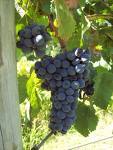Wait! I hear the pedants among you, as is to be expected, quibbling.
II. Wait! I hear the pedants among you, as is to be expected, quibbling. “How do I know this,” they ask? (They have to; that’s why we call them pedants.) It was a process of conjecture and refutation. (Scholars will get the allusion, and others will not. They should do more reading.) My first clue was to read the labels which offer a myriad of descriptions (often quite erroneous, to this student of the grape) of the flavors within the bottle. No two rosés seem to have the same description, nor even the same colour. Moreover, when the grape constituting the wine was listed on the label, I found a variety. But more importantly, I noticed that many rosé labels, though offering a flowery description of the wine, passed in silence on the grapes used. At first I thought this silence was a quality indicator. If the grape type(s) was inferior then there would be no mention. So I could use silence as a surrogate of quality. This inference did not stand up to the taste test, for taste them I did.
I said I found a variety of grapes used in the making of rosés. Indeed. Here the flow of prose pauses while I consult a portion of the database. Here is a selection of the grapes types proclaimed :

Agiorgiko, alcente, barbera, cabernet franc, cabernet sauvignon, cambourain, carignene, chardonnay, churbono cinsault, frapporto, gamay, grenache, groulleau, malbec, marsanne, mataro, merlot, molinara, monastrell, montepulciano, mourvede, mucat á petit grains, nebbiolo, negroamaro, nero d’avola, pinotage, pinot gris, pinot meunier, pinot noir, riesling, rondinella, ruby cabernet, sangiovese, shiraz (syrah), tempranello, tinta barroca, tinta roriz, touriga, and zinfandel. (Yes, grammarians will have by now noted my use of the Oxford comma.)
Imagine trying to spell check that list. For reasons unknown the Microsoft spell checker insists on capitalizing Riesling (see) but not chardonnay or shiraz, but which recognizes them all as words. Go figure.
A few qualifications are in order. Zinfandel is put in some things called rosé as distinct from the egregious (but ever present Stateside) white zinfandel, once called blush (and one should, if caught drinking it). A close reader will notice several white wine grapes in that list, like chardonnay, riesling (I have surpassed the capital), and pinot gris. Similarly it is noteworthy that some noble red grapes are used: cabernet sauvignon. “Noble grapes?” I hear you think. (Reader, you have no secrets from me.) The French defined this term, purely objectively, to class those grapes which can make a fine table wine without the need to blend in another kind of grape. (Blending of different grapes is very common.) By coincidence the only noble grapes are those native to France. Voila!
To be continued.
